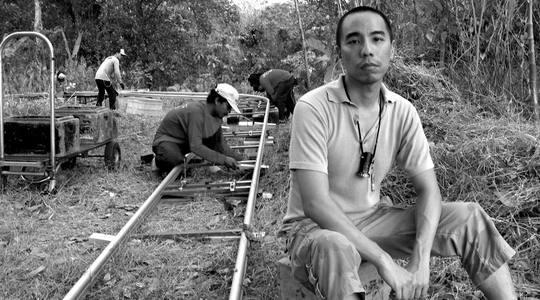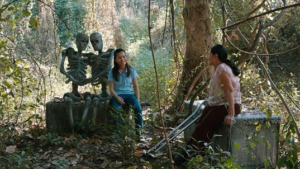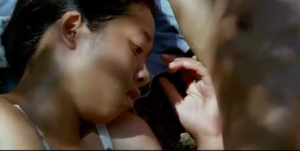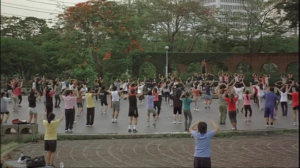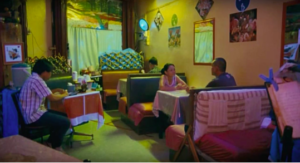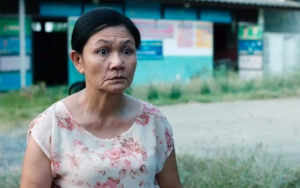After two hours of meandering, disconnected people—both citizens of the present-day Thailand and souls of the distant past—wandering the streets and schools and hospitals of Khon Kaen, Cemetery of Splendour dedicates one of its final shots to a humdrum aerobics scene. The director can’t even bother to place the camera in front of the crowd, or provide a bird’s eye view, or even navigate around the workout. For several minutes, he provides the viewer with a static shot behind the group of older women, who are laughing, smiling, and slowly following the teacher’s instructions as light Korean pop music plays in the background.
But then, as a young man named Teng sidles into the routine, a voiceover mixes with the music, reading a poem with a level of gravitas that supersedes the lackadaisical energy of the workout:
There’s a mountain of bricksIt spreads out like a flower blossom
It stretches to the sky
To devour the sunIt is very far away
It looks ominous and fearsome
It pretends to be…
A pure and flawless being
Pretends to be as soft as a child’s palmBefore it disappears
The wall bulges
And changes shape
As if it knows, that when it fallsIt would be an astounding sight to behold
As the voices drifts away, the aerobics participants begin to march in place, and the camera slowly pans left. In any other film, this pan would carry very little (if any) meaning. But for the previous 120 minutes of film, The film has blessed the viewer with only one (seriously, one!) scene that involved camera movement. So there is actually nothing ordinary about this momentum shift. This isn’t just another aerobics class. These people aren’t just marching in place because it’s the next step of the exercise routine. As we assess the situation, it becomes undeniably clear there is a division between the characters and the world—there is another entity, a grander power, an undeniable force pulling the strings.
And that force is Apichatpong Weerasethakul.
Deciphering what exactly makes this moment powerful, however? That requires us to dig through Weerasethakul’s filmography and assess exactly what divide the filmmaker is exposing and exploring.
Inquisitive vs. Submissive
While many reviewers and moviegoers have correctly pointed out Cemetery of Splendour’s biting political commentary on war and dictatorship, there’s actually something much deeper at play thematically and stylistically. By observing the final scenes throughout Weerasethakul’s filmography, we can find why this seemingly inconsequential, plodding moment at the end of Cemetery of Splendour is, in fact, the culmination of Weerasethakul’s contemplative, disciplined approach to filmmaking and storytelling.
He’s exploring a deep, existential divide we all constantly try to overcome—the divide between passiveness and actively trying to unite with a deeper energy; the divide between “who we are” (both individually as people and together as a society) and “who we’d like to become.” And with each successive film, he’s refined his method of visually capturing that metaphysical connection that binds us all.
The following exchange between Weerasethakul and Slant Magazine exemplifies the core struggle of five Weerasethakul films: Blissfully Yours; Tropical Malady; Syndromes and a Century; Uncle Boonmee Who Can Recall His Past Lives; Cemetery of Splendour.
You’ve previously spoken about the government takeover in Thailand and how several of your friends and artists you know have been jailed as a result. In your eyes, has the political climate changed since making the film?
I think the people are getting less submissive. But there are really two extremes that you realize when a country is under dictatorship. You find people who are very very okay with being submissive and then you find a camp that’s the opposite. I think it’s a good thing, but to live it sometimes is quite difficult, but I think it’s exciting to be alive at this time, to witness it.
In general, if you’re in a creative career it can be quite suffocating because sometimes you’re not sure how long you’re going to live in the system and how long you’re going to be able to keep coming up with different people. You maybe try not to speak straightforwardly. It can be hard if you’re not saying the truth, not saying something subversively, but that can be boring too, to do everything subversively.
That last part of the quote—”That can be boring…to do everything subversively”—highlights the absolute power of the ending of Cemetery of Splendour (and, personally, why it is has been such a joy to sift through Weerasethakul’s filmography). Labeling his films as “political” or “subversive” honestly undermines the breadth and ambience of the worlds and characters he’s constructed. The ostensibly meaningless pan of the aerobics class in Cemetery of Splendour, at its core, showcases the bifurcation that exists within each of Weerasethakul’s films: The blossoming love between a young couple juxtaposed against an old woman’s fading energy in Blissfully Yours; Keng excitedly and awkwardly searching for love in the real world versus his quiet, ominous journey through the jungle in Tropical Malady; the rural, green landscape pit against the urban, concrete environment in Syndromes and a Century; the memories of Boonmee’s past lives versus the decay of his present body in Uncle Boonmee Who Can Recall His Past Lives.
So, to repeat: That bifurcation isn’t just subversive or political. That divide is…human. It’s real. It’s existential. That distance between “who your are” and “who you’d like to become” is a struggle that you and I experience on a daily basis.
Remember when Weerasethakul said, “You find people who are very very okay with being submissive and then you find a camp that’s the opposite”? That boundary between “submissive” and “inquisitive” is where Weerasethakul’s characters always rest. Really, we all rest there from time to time. And that moment where we decide to either submit to an unyielding power or search for a deeper connection to the world is represented by that moment where the camera pans from right to left at the end of Cemetery of Splendour. Let’s see how Weerasethakul has built to this moment throughout his career.
Blissfully Yours

Blissfully Yours begins with two women—the young Roong and the much older Orn—standing around a young man named Min at the doctor’s office as he gets checked for a painful rash covering his skin. This closed quarter, naturalistic awkwardness is the polar opposite scenario of the film’s final scene, which finds those same three main characters lounging in the woods at high noon. A couple sits on one side, and a lone woman sits on the other side.
Those woods represent something so emotionally and psychologically contrasting to the clinical doctor’s office, where Min sits still and receives instructions from someone else on how to improve his condition. Min is Burmese and can’t even properly communicate with the doctor because it would give away he’s an illegal immigrant—this bleeds into his deeper desire to become part of Thai culture, which he partly achieves by embarking on a romantic relationship with Roong. They explore this desire for an deeper connection in the woods, where a simple handjob takes on the form of a blossoming flower—a visual, sensual display of Min building a new identity in a new country.
Just as Min is building that new identity, we see Orn struggling to retain hers. Orn is desperate to have another child, but her husband is practically incapable of finding her attractive or fueling any kind of romance. In a desperate moment, she mimics Roong and Min and escapes to the woods to have sex with her husband. Later in the day, she meets up with the young couple, and their combined energies create for a disoriented morning. Thus, the difference between beginning and end of Blissfully Yours carries a ton of meaning, emotion, confusion, longing.
And, to be brutally honest, it’s a completely obvious and ordinary juxtaposition…especially compared to the supernaturalistic wonder achieved at the end of every single one of Weerasethakul’s following films. The ending is definitely earned—don’t get me wrong. The short distance between Orn and Roong & Min in that forest feels like mountainous, treacherous, uncrossable terrain. The connection Orn desperately seeks to attain is so readily available to Roong and Min, yet those two are none the wiser about Orn’s draining will to carry on as is.
With all that said, it still remains that Weerasethakul’s visual imprint on the scene begins and ends with the composition of where these characters are lying. It’s undoubtedly impressive, but he’s one step away from something transcendent in Tropical Malady.
Tropical Malady
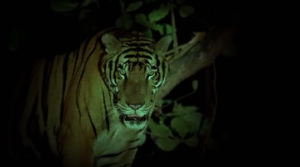
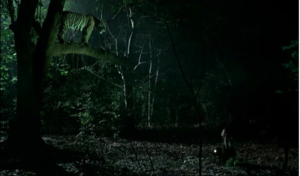
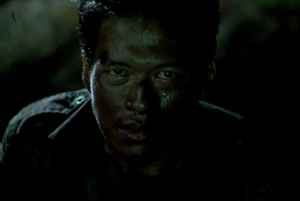
The tiger trails you like a shadow. His spirit is tired and lonesome. I see you are his prey and his companion. He can smell you from mountains away. And soon you will feel the same. Kill him to free him from the ghost world. Or let him devour you and enter his world.
As Keng silently maneuvers through the rainforest, a monkey jumps around overhead, saying those words. The entire scenario an inexplicable leap from the commonplace, sobering portrait of blossoming love that penetrates Tropical Malady’s first half. Much like Blissfully Yours and Syndromes and a Century, Weerasethakul resolutely establishes the “divide” plaguing his characters in Tropical Malady by quite literally splitting the film in two, placing his characters in two entirely different settings—he moves us from the everyday Thai streets to a mysterious jungle where Keng’s love, Tong, has turned into a mythological tiger.
This tiger encapsulates the core fears for Keng. Legend has it that a “tiger” has taken on forms of many different people who fall victim to its spells—much like Keng who has already become smitten by Tong. Thus, Keng has become this tiger’s “prey” and “companion.” Keng can either spend his time fixing Tong and returning him to a normal life, or he can accept Tong as he is and become enraptured by his lifestyle, his world. At its heart, once you wade through all the mythological framing, this is all very much a common scenario anyone entering a relationship encounters: We must learn to accept someone’s faults, which requires us to abandon our own fears of relationships and show a lot of bravery in accepting others for who they are.
That fear is masterfully displayed by Weerasethakul through Keng’s ominous journey through the jungle—a setting that quite literally represents Tong’s daunting imperfections and shrouds the love-stricken Keng. But as Keng moves forward, with the possibility of the tiger devouring him, we see that he’s more and more willing to abandon his fear and take on Tong’s drawbacks.
That culminates with the moment where Keng finally confronts Tong one-on-one. Tong rests in a tree above, and Keng bends in front of his lover, manically shaking and sweating in a moment where his commitment to loving Tong is ultimately challenged. And then, Tong speaks to Keng:
And now…I see myself here. My mother. My father. Fear. Sadness. It was all so real…so real that…they brought me to life. Once I’ve devoured your soul, we are neither animal or human. Stop breathing. I miss you…soldier.
It’s in this moment where Weerasethakul truly moves beyond the literal boundary constructed at the end of Blissfully Yours—he’s allowed Keng to not just let the stories of this mythological tiger scare him away, and instead respond to Tong and form his own story:
Monster…I give you my spirit, my flesh…and my memories. Every drop of my blood sings our song. A song of happiness. There…do you hear it?
Allowing that connection to take place is rewarded with the film’s final shot—a cave painting depicting Keng offering his energy to Tong. The ending visually captures Keng overcoming his fears, while also poetically displaying the beauty of this connection coming to fruition.
Syndromes and a Century

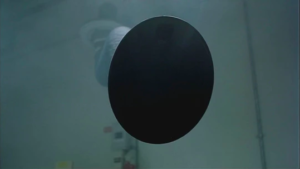
That tangible connection that is missing from Blissfully Yours and established in Tropical Malady exists in a muted, ethereal form in Syndromes and a Century.
It is, in fact, so intangible and abstract and exquisite that it naturally ends with a shot that is seemingly ordinary, yet so stylistically antithetical to the conversational nature of the film that you can’t help but wonder what sort of profound statement the director is searching for. And, just like Cemetery of Splendour, the film closes on a shot of an aerobics class taking place in a park.
Much like Tropical Malady, Syndromes and a Century has two distinct halves that shift between a hospital in a rural environment and a hospital in an urban environment. The bifurcation on display is, as a result, quite obvious and easy to decipher: People form deep, emotional connections with nature and one another in the rural setting, but grow distant and disinterested in the urban setting.
A simple reading of the film would posit that Weerasethakul is longing for simpler times, is making a case for human interaction over technological development. And perhaps that is the case on a basic level. But for the final shot of the film to truly gain power, the director must strive to provide catharsis for a deeper issue. Where Blissfully Yours and Tropical Malady concentrated its efforts on a core group of two or three individuals, Syndromes and a Century expands to unite an entire subset of individuals searching for all kinds of different answers. If you were to compare Weerasethakul to Paul Thomas Anderson, Tropical Malady would be Punch Drunk Love, and Syndromes and a Century would be Magnolia. The connection in the former is clear; the divide in the latter is dauntingly difficult to define.
The latter, as it also turns out, is much more universal. Because while we often seek the company of others and determine those people to become the antidotes to our problems, the larger, looming issue is how we fit into the grand scheme of things, of society, of existence. In a mass of people—as on display with the film’s closing shot—where do we fit as individuals? Thus, the divide on display at the end of Syndromes and a Century isn’t simply defined as it is in Blissfully Yours, but ambiguous and impending and overwhelming.
Just before the aerobics scene, there’s a haunting shot of a machine consuming the smoke out of the basement of the hospital that housed the characters of the film. As it sucks the room dry, the black hole bears a striking divergence from the solar eclipse that enveloped the characters while conversing out on a green pasture earlier in the film. “How cruel. This is a powerful place,” one of the characters notes as it grows dark because of the eclipse.
As the film shifts from that eclipse to the hospital basement to the literal unification of everyone in the aerobics scene, we see that Weerasethakul has crafted an environment where—even though people have lost their connection with nature and have shifted away from deep, personal conversations—people have intrinsically created a setting where they can all gather for a joyous joint exercise. It’s an ending that doesn’t provide answers like it does in Tropical Malady, but instead showcases the struggles we all share and our collective relentlessness to find meaning in this confusing, constantly changing world.
Uncle Boonmee Who Can Recall His Past Lives
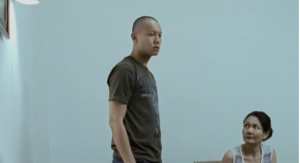

Uncle Boonmee Who Can Recall His Past Lives throws a curveball at us before it ends—something we, as viewers have not been privy to thus far in Weerasethakul’s filmography: the absence of the main character. After spending the entire film connected with dead and lost loved ones, recalling his past lives, and looking into the future, Boonmee’s final drips of life drain away as he sits with his family and friends in a cave. After that, we are stuck with Tong and Jen as they stay at an area hotel.
From there, we voyeuristically sit in on an ordinary night, where Tong and Jen watch television, makes jokes, and try to cope with their loss. But, then it happens: As Tong and Jen get up to go grab some dinner, they suddenly see duplicates of themselves sitting on the bed, still watching television.
And while that mysterious ending, on a surface level, doesn’t quite set up an ending in a linear fashion like Weerasethakul’s past films, it does introduce a crucial divide that marks yet another step in the filmmaker’s prowess: In the face of death, Boonmee recalls his past lives and seeks connection with his family—but then we cut to Tong. And Tong is in these very enclosed, clinical places, that, as with Blissfully Yours, contrast the forest. Tong doesn’t just recall his past lives though—he can see his current life split. And that split takes the form of the passive viewer who sits in front of the TV, and then a more active person who goes out into the world.
Except even in the world, at a restaurant, Tong and the woman have to wait for service that never comes. So, despite taking two different actions, both end up sitting there, powerless, passive.
“Active” and “passive” are the key traits, here. Boonmee was active in trying to find meaning in his past lives, in connecting with lost loved ones, in attempting to better himself before his body gave away; Tong and Jen, on the other hand, are experiencing a dose of the opposite end. With this abrupt shift in tone, Weerasethakul poetically highlights what happens when we choose to be passive individuals, and all that can be lost when we give up on continually developing.
Cemetery of Splendour

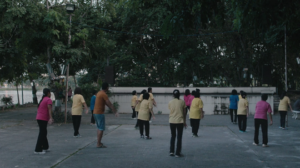
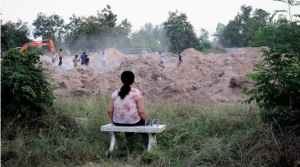
Let’s bring back that poem we hear at the end of Cemetery of Splendour one last time:
There’s a mountain of bricks
It spreads out like a flower blossom
It stretches to the sky
To devour the sunIt is very far away
It looks ominous and fearsome
It pretends to be…
A pure and flawless being
Pretends to be as soft as a child’s palmBefore it disappears
The wall bulges
And changes shape
As if it knows, that when it falls
It would be an astounding sight to behold
Much like Syndromes and a Century, there exists characters from two entirely different settings in Cemetery of Splendour. However, as opposed to witnessing both those worlds and observing how they’re different, we are partnered with just two main characters from present day: Jen and Itt.
Jen is an old woman whose right leg has practically given up on her. The large swelling has consumed her leg from the knee up, despite the medicine she has bought from people promising a remedy. After losing her husband and being alone for years, she has married an American man who speaks very little Thai but provides her the company she desperately sought for so long. Her husband does not, however, seem to provide the deeper, emotional connection she requires to fathom why she’s been cursed with a condition that physically limits her ability to transverse her childhood hometown.
Itt, in turn, represents a chance to form that connection. Itt is one of many Thai soldiers stricken with a sleeping disorder that causes them to drift off at a moment’s notice. We don’t learn much about Itt’s past, but we do come to understand the thematic relevance of his condition—his mysterious exhaustion is caused by the ancient warriors who once battled on the site that lies beneath the clinic. The former soldiers are still fighting their old battles, and require energy from current soldiers fighting new ones.
While, once again, you could point out the clear political ties and anti-war statements, those sentiments don’t entirely capture the humanistic elements of the film. To Weerasethakul, the divide between people and government isn’t as interesting as the psychological divide between Jen and Itt. As her life and body begin to give up on her, Jen views Itt as her “new son” and a chance for a new start. That’s why, even as Itt drifts off to submit his energy to ancient warriors, Jen spends her time befriending a psychic named Keng to speak with Itt in a distant slumberland. As we learn, when he sleeps, Itt is transported to the ancient site that once covered where the hospital now rests. Through this ghostly connection, Jen is able to escape the real world where her problems seem unsolvable and transport herself to a body that is healthy and an environment that isn’t being wiped away by the Thai government. Jen connecting with Itt is Jen connecting with the ancient Thai soldiers that have bonded with Itt, which signals why, just before the aerobics scene, a piece of microchnodia floats across the sky, representing the connection between body and earth Jen has achieved.
And that leads to the other important part of the ending of Cemetery of Splendour—the actual final shot of the film is Jen staring wide-eyed, mouth agape as children play soccer on a dirt field the government is digging up in order to build a technological center that will overtake the clinic. She has been taught by Keng to keep her eyes wide open in order to form the ethereal connection with Itt as he sleeps, and her resoluteness to remain focused in the face of physical destruction recalls Weerasethakul’s quote in his interview with Slant Magazine:
I think the people are getting less submissive. But there are really two extremes that you realize when a country is under dictatorship. You find people who are very very okay with being submissive and then you find a camp that’s the opposite.
So, now, let’s circle back to that aerobics scene. Unlike the exercise routine in Syndromes and a Century, the routine in Cemetery of Splendour features participants all dressed in the same outfits. It’s much less upbeat. There is, for lack of a better word, a very “robotic” nature to these people. And after we hear that poem describe the building, the decay, and the reconstruction of environments, the camera pans from right to left.
As mentioned, only one other scene in the entire film featured camera movement, and it was a moment when Jen and Itt went out into the night, where the nightlife aesthetics suddenly blended with the colorful tubes that flood the soldiers’ shared hospital room. Being the only scene in the movie filmed at night, Weerasethakul connects the sleeping state of the soldiers with the environment that exists outside their constant, eternal, centuries-old war. And as the woman who take Itt out into the night, Jen is an integral part of that connection.
So, when the camera pans over that aerobics class, it turns out to be a stylistic choice that isn’t merely making a boring scene more watchable—it’s a callback to Jen and Itt’s shared connection from that night earlier in the film. The camera movement represents the difference between the people marching in place, taking orders from their instructor and a woman ready to open her eyes wide and find deeper connections at play. If anybody wants to overcome a invisible, seemingly indefinable divide, Weerasethakul is suggesting to reach back to the inborn, connective tissue that binds us all and never settle for the ordinary—if you really want to grow and form meaningful connections, don’t be submissive, be inquisitive. Keep your eyes wide open.

